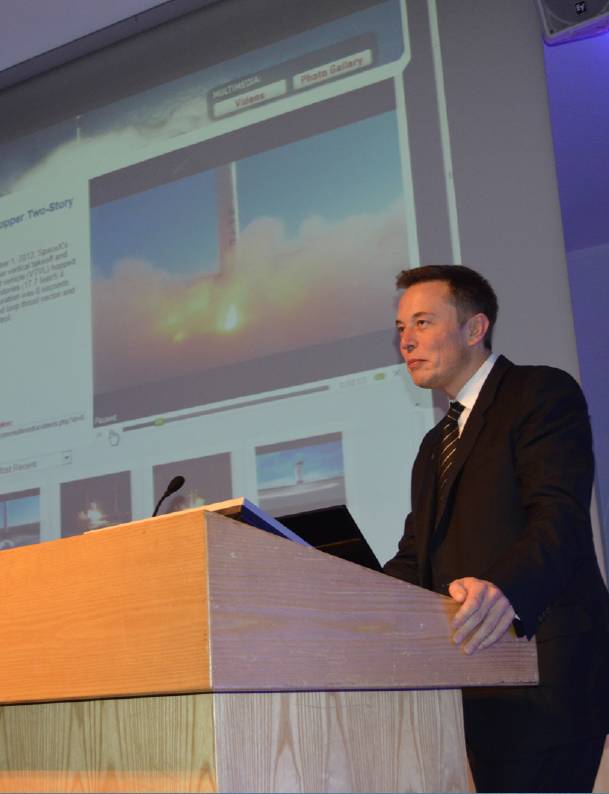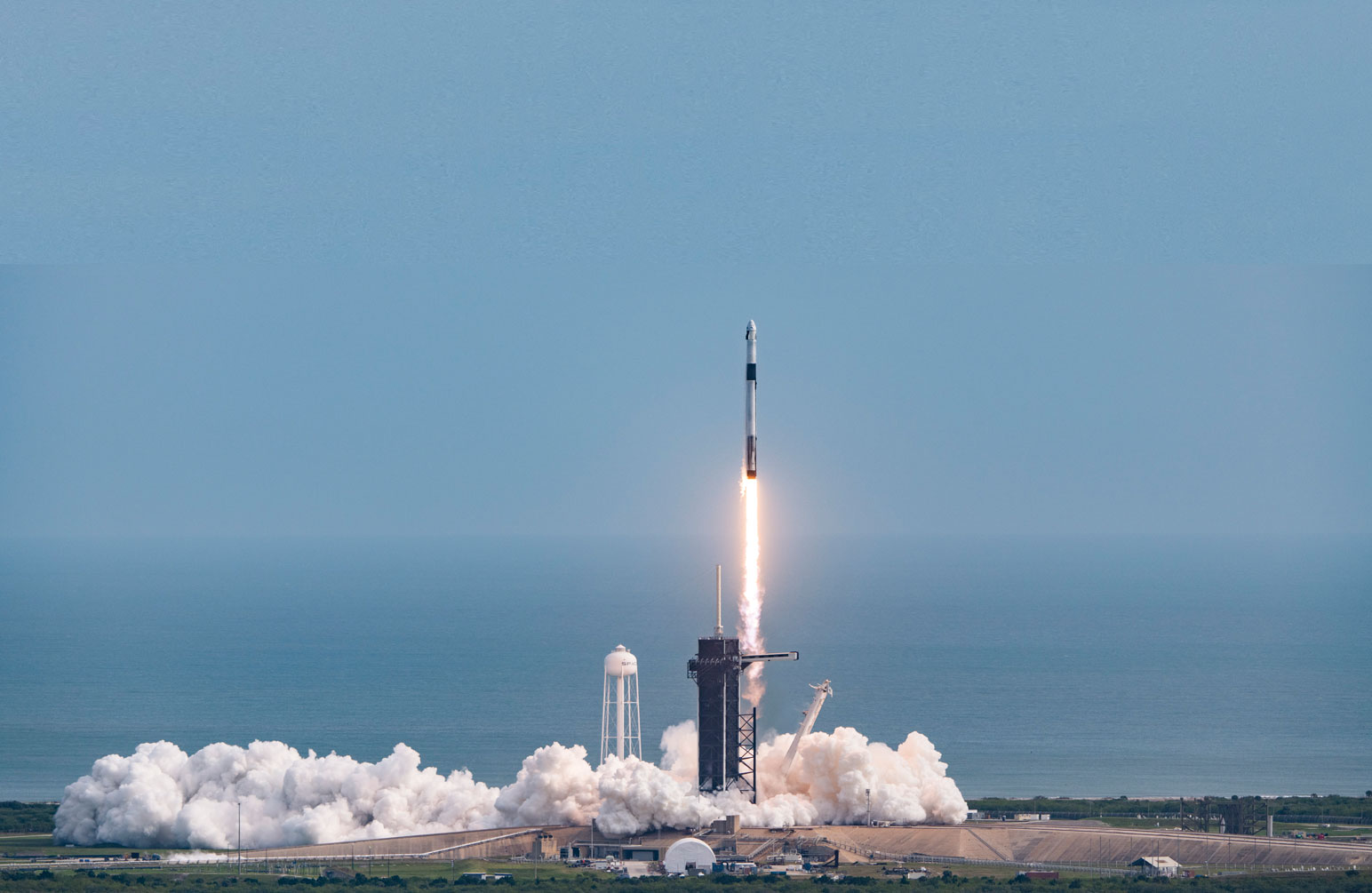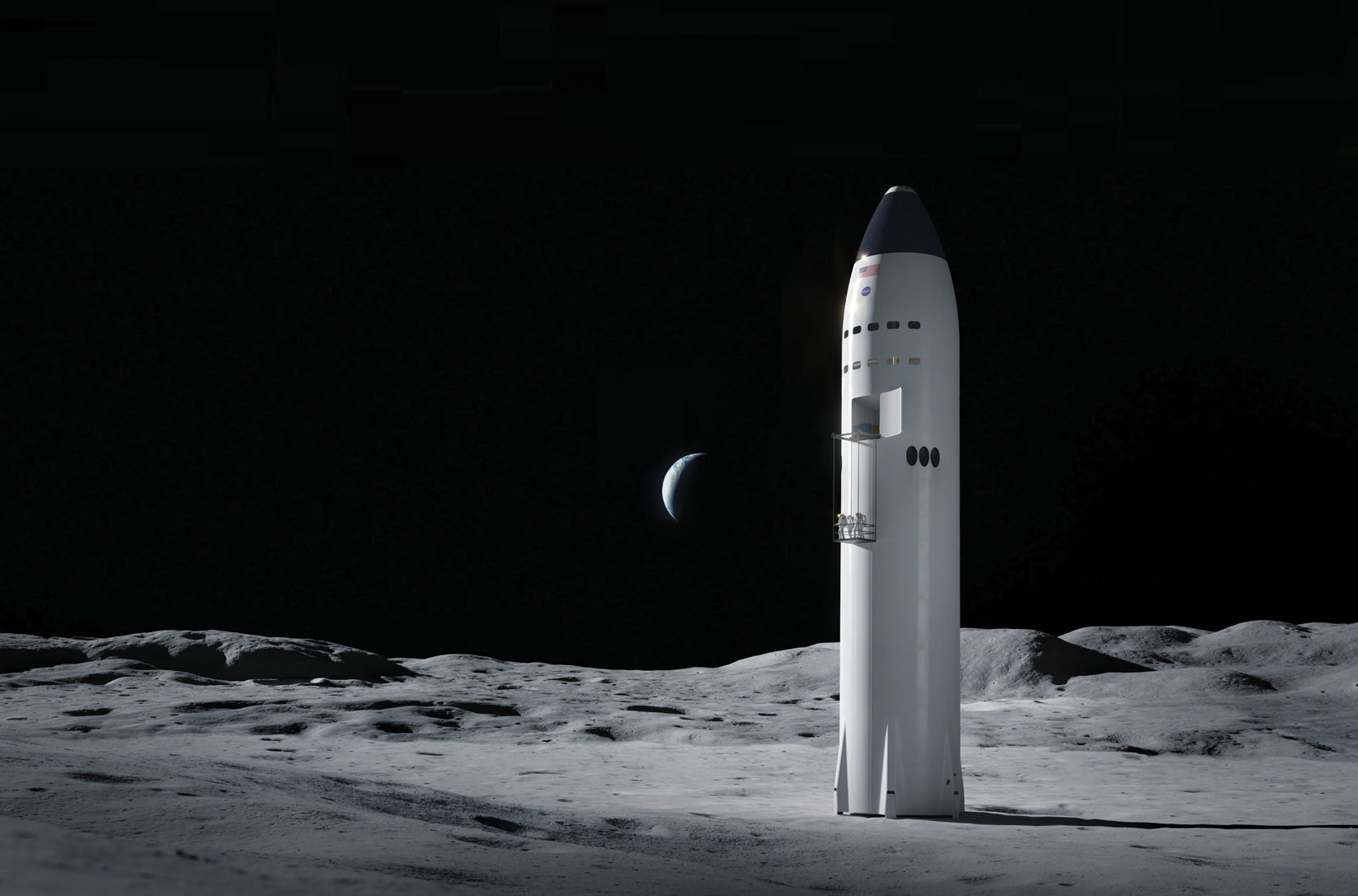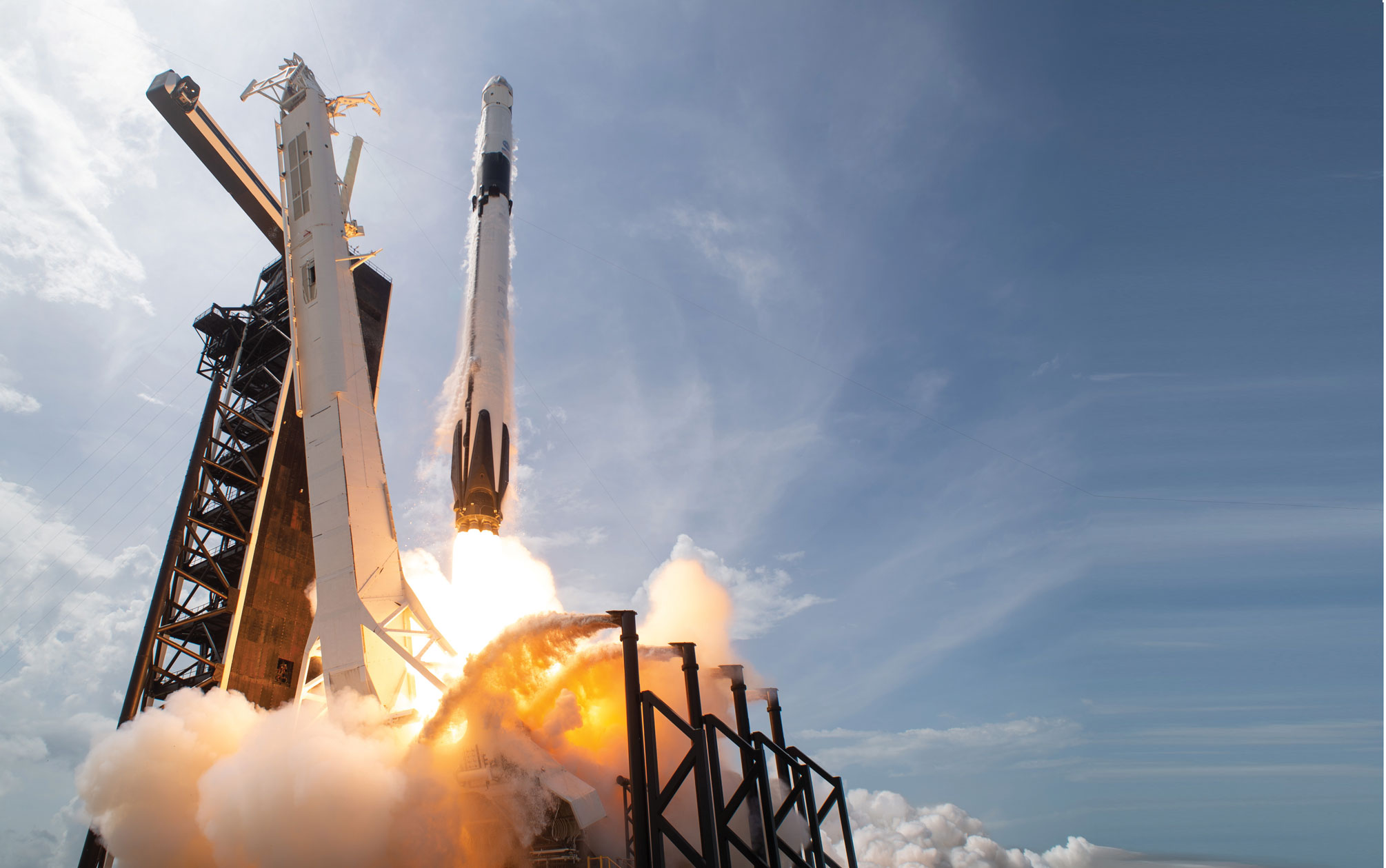SPACEFLIGHT SpaceX strategy
Live from Mars!
PAT NORRIS FRAeS (member of the RAeS Space Specialist Group Committee) assesses the ambitious plans of SpaceX and its charismatic CEO, Elon Musk, to send humans to Mars and to provide broadband links here on Earth.
 Elon Musk speaking at the RAeS in 2012.
Elon Musk speaking at the RAeS in 2012.
On 30 May 2020 Doug Hurley and Bob Behnken were the first astronauts in almost nine years launched into space on an American rocket at the start of a 19hr journey to the International Space Station (ISS). Hurley had been on the previous such flight, Space Shuttle mission No. 135, when it took off from the exact same spot – Pad 39A at Cape Canaveral in Florida – its launch on 11 July 2011 bringing the Space Shuttle programme to a close. The same pad was the starting point for all of the Apollo Moon landing missions.
In the intervening nine years the US has paid Russia for 35 separate seats in the regular Soyuz launches taking cosmonauts to the ISS. The current sticker price for each seat (round trip) is about $90m and the political costs have also been high, since being dependent on Russia for anything is not good politics in the US at the moment.
The Crew Dragon spacecraft into which Hurley and Behnken were strapped and the Falcon 9 rocket that blasted it into space were both designed and built by SpaceX. The design of all previous crewed space rockets had been managed by governments – and just three of those: Russia (Soviet Union), US and China – so this was a first for a commercial company. The private sector origin of the technology was especially visible in the sleek, designer-style spacesuits worn by the astronauts, in contrast to the baggy ‘pumpkin’ suit of previous missions.
Returning the US among the stars
Republican Congressman turned NASA Administrator, Jim Bridenstine left it to his bosses, President Donald Trump and Vice President Mike Pence, to blow the ‘America is great’ trumpet at the Cape Canaveral launch. Bridenstine will use the success to persuade Congress to increase the NASA budget. The approximate $50m SpaceX charges NASA for an astronaut launch is, of course, also a welcome price reduction.
"(MUSK) TOLD AN AUDIENCE AT THE ROYAL AERONAUTICAL SOCIETY IN LONDON IN 2012 THAT HE WOULD LIKE TO DIE ON MARS “BUT NOT DURING THE LANDING.”
The man most applauded for the event was Elon Musk, founder and CEO of SpaceX. Musk is an eccentric billionaire who has built his SpaceX business from the ground up into a company valued at more than $30bn in just 18 years. He is perhaps better known for also creating from nothing, the electric car company, Tesla, and his Twitter musings have sometimes made headlines for the wrong reasons.
Musk’s eccentricity was highlighted in his statement after the launch that it was “the first step toward a civilisation on Mars”. The stretch from two astronauts on the ISS to having a civilisation on Mars seemed ridiculous to most people. However, Musk founded SpaceX to go to Mars, so for him it seemed natural. He sees Mars as a backup to Earth in the event of a third world war, and also as an extraordinary adventure. He told an audience at the Royal Aeronautical Society in London in 2012 that he would like to die on Mars “but not during the landing”.
This is not the first time the US has got itself into the pickle of mothballing its only astronautrated launcher and having to wait several years for the replacement to be ready. After the last launch of an Apollo-era rocket in July 1975, it was almost eight years before the next American astronauts made it into space on the first flight of the Space Shuttle in April 1981. The gap this time round was supposed to be four years, 2011 to 2015, but this had slipped to 2017 by the time parallel contracts were placed with Boeing and SpaceX. Further slippage ensued: to 2020 for SpaceX and probably 2021 for Boeing – leading Musk to declare on 30 May that the pace of development needed to accelerate if humans were to get to Mars in his lifetime.
 All images: SpaceX
All images: SpaceX
Re-using the rocket
SpaceX has undercut all of the world’s rocket suppliers by being commercially-focused. The technology is chosen for cost and reliability, not because it is hi-tech. The manufacturing is mostly done in-house, enabling trade-offs and design changes to be made more easily than with a long supply chain.
In his talk at the RAeS, Musk noted that the cost of the fuel was less than 2% of the overall launcher cost, hence his decision to recover the rocket’s first stage instead of letting it fall into the ocean. After boosting the second stage and its payload towards space, the first stage of the Falcon 9 navigates itself back to a platform floating in the ocean and lands vertically on it – for most observers this is like watching a scene from a science fiction movie. NASA insisted on using a pristine first stage for the 30 May flight but has since agreed to allow the use of boosters that have previously flown. The cost of preparing an already flown booster for reuse has not been disclosed and it is not clear how much of a saving it provides. One major cost incurred is the need to preserve fuel during the flight so that the first stage can power its way back to a landing, thereby reducing the payload it can carry into orbit by a reported 30%.
The latest variant (Block 5) of the nine Merlin engines used in the Falcon 9 first stage is designed to be re-used ten times with minor processing and up to 100 times with refurbishment. Five launches is the most any booster has so far achieved, allowing the first 35 Block 5 launches to be made with a total of just 17 different Block 5 engines.
SpaceX also recovers the fairing that protects the payload on top of the rocket and reuses it. The fairing floats down on parachutes to be recovered at sea. Musk told the RAeS audience that each fairing costs about $5m, so it’s worth trying to reuse them. Note that no other space rocket manufacturer anywhere in the world is able to recover and reuse its rockets, putting SpaceX truly in a class of its own.
Falcon Heavy
Another of SpaceX’s unique products is the Falcon Heavy launcher which can carry into orbit more payload than any other launcher in the world – a lot more! It can place about 64 tonnes into orbit, which is more than double the capacity of the next most powerful rocket, the Delta IV Heavy. It has been launched three times and is very competitively priced.
It helps to be based in the world’s biggest economy. Since its first flight in 2010, 38% of Falcon 9 launches have been for the US Government – initially for NASA but, since 2015, also for the Department of Defense. In the same period, only 14% of the launches of Europe’s Ariane 5 rocket (Falcon 9’s main commercial competitor) have been for government agencies. However, Europe funded the cost of developing Ariane 5 while Musk used his own money to pay for most of the development of both the Falcon 9 and the Falcon Heavy, getting the rocket close to an operational state before bidding for and winning contracts from NASA and the commercial market.
Building both the rocket and the spacecraft on top of it is an important SpaceX feature. Musk’s dream of flying to Mars requires a very powerful rocket (about which more in a moment) and a sophisticated vehicle to reach and land on Mars – and then to take off again and return to Earth. The Crew Dragon capsule that carried Hurley and Behnken to the ISS on 30 May is the first SpaceX vehicle certified to carry humans. However, the cargo version, called simply Dragon, has carried fuel, water, food and supplies to the Station 20 times in the past eight years and brought cargo safely back to Earth. Dragon is the only spacecraft able to return a significant amount of cargo (3½ tonnes) – the Russian Soyuz can bring back just 50kg along with three passengers (150kg if there are only two passengers). All the other cargo vehicles (Russian, American, Japanese, European) that bring supplies to the ISS burn up on re-entry into the Earth’s atmosphere.
 Artist’s rendering of the SpaceX Starship concept.
Artist’s rendering of the SpaceX Starship concept.
Starship – even bigger
With his vision of Mars in mind, Musk has been investing heavily in a new generation of launchers and spacecraft. He has been expected to enhance the successful Falcon Heavy rocket but instead has gone back to the drawing board and is developing a colossal rocket/spaceship combination called the Starship system. The second stage is called Starship and, as well as a rocket, it is a crew and cargo vehicle capable of long-duration missions, eg. to Mars. The first stage is currently called Super Heavy.
Everything in the Starship system will be recovered and reused – not just the first stage. Starship will be comparable in carrying capacity to the Saturn V of the Apollo era, ie. able to loft in the region of 150 tonnes into orbit around the Earth. However, Saturn V was an expendable rocket with its parts ending up at the bottom of the Atlantic Ocean or as space junk. Musk reckons that, if Starship were expendable, its payload capacity would be doubled. Setting a development timescale of just three to four years and a budget of about $5bn (“between $2bn and $10bn” says Musk) means that the technical challenges are enormous. So far, development of a prototype of a scaled down first stage has been ‘exciting’ with explosions and other mishaps destroying or damaging most of the early test articles. SpaceX has put in place a manufacturing process for the rocket that underpins a ‘build-a-little test-a-little’ approach, so that the design of the final product evolves as the testing progresses.
Musk admits that success of the development is not assured given the many technical hurdles to be surmounted. His confidence has been boosted by NASA selecting Starship as one of three contenders for its return to the Moon – the other contenders are Dynetics, a 2,000 personnel hi-tech company based in Huntsville, AL, and a team led by Jeff Bezos’ Blue Origin that includes Lockheed Martin and Northrop Grumman. NASA will give SpaceX $135m to design a lunar landing variant of Starship and a similar contribution has come from Japanese fashion retail billionaire Yusaku Maezawa who paid for a trip with eight friends around the Moon and back.
To send the Apollo astronauts to the Moon required the Saturn V to be five or six times more powerful than was needed for any other space mission, so it was uneconomic for anything except a Moon landing. SpaceX is planning to turn this argument on its head with Starship. Its full reusability will make it so cheap that it will be suitable for launching normal satellites, in other words replacing the workhorse Falcon 9. That at any rate is the commercial logic espoused by Elon Musk. A sceptic might say that a competitor could develop a smaller reusable rocket that would provide even cheaper launches and thus undercut Starship.
So the challenge for SpaceX is not only to complete the ambitious Starship development in a timely and affordable way but also to ensure that it is commercially competitive in operation.
Making the sky bright
The Crew Dragon launch is not the only headline SpaceX has made in recent months. Astronomers have been critical of the several hundred Starlink satellites that SpaceX has built and launched into orbit round the Earth intended to provide global broadband services. The satellites reflect sunlight before dawn and after dusk, and are so numerous that the accumulated ‘light pollution’ is significant – one American astronomer reckons about 30% of her images will be contaminated.
The initial constellation of Starlink satellites will number about 1,500, of which about 500 are in place as of June 2020, with expansion plans already announced to increase that to 10,000. In response to astronomers’ complaints, SpaceX is applying a low reflectivity coating to the satellites and is testing a sunshade that would be deployed to reduce reflected sunlight. Each satellite weighs about 250kg with an ingenious flat design about the size of a 20cm thick ping-pong table which is packed with electronics and includes a solar panel that unfolds once in orbit. They are launched on a Falcon 9 in batches of 60 using a clever packing strategy inside the rocket fairing.
SpaceX is funding the development and launch of the satellites from internal funds, with the total cost of the initial constellation said to be about $10bn. Orbiting the Earth at an altitude of about 550km, the Starlink satellites move rapidly across the sky. A broadband user therefore has to track the satellite as it moves, and switch to another one when it goes over the horizon. Most current telecommunication satellites are at an altitude of 35,000km in the so-called geostationary orbit, making them appear fixed in place to the user – hence the unmoving satellite dishes on the side of houses. The lower altitude orbit makes the round-trip signal delay time much shorter than for geostationary satellites. This ‘low latency’ can be important for some applications such as real-time gaming as well as to avoid the embarrassing pauses often seen on TV news feeds. But the downside is the need for higher-cost user equipment that can track the satellites – the Starlink user’s antenna is expected to be flat and about the size of a medium-sized pizza box which tracks the satellites electronically and thus avoids any physical movement, although the early beta versions are dishes that move to track the satellites. Sceptics point out that the greatest potential for new Internet users is in emerging markets but they have little need for low latency.
MUSK’S PROJECTION IS THAT, BY 2025, STARLINK WILL HAVE BROUGHT IN REVENUES OF ABOUT $30BN – REVENUES THAT WILL HELP UNDERPIN THE COST OF DEVELOPING THE GIANT STARSHIP LAUNCHER AND SPACECRAFT.
Previous attempts to use lower altitude orbits for telecommunication services fared badly 20 years ago but SpaceX hopes that advances in technology will make the difference now. One bad omen is that OneWeb, another company using low altitude orbits to connect users to the Internet, filed for Chapter 11 bankruptcy protection in March 2020, having run out of cash to pay for the construction and deployment of the hundreds of satellites it needed to provide a service. The challenge for SpaceX is to build and launch enough satellites to begin its broadband service and thus allow the revenue to start rolling in. A Beta version of the 1GB broadband service is expected to start in the US and Canada in late 2020 and go global in 2021. Musk’s projection is that, by 2020, Starlink will have brought in revenues of about $30bn – revenues that will help underpin the cost of developing the giant Starship launcher and spacecraft.
One side effect of the Starlink initiative is that SpaceX is now starting to compete with some of its commercial customers – organisations such as SES and Inmarsat that are targeting the same global broadband market as Starlink. These organisations would normally consider using SpaceX to launch their satellites but will they now hesitate to do so?
 All images: SpaceX
All images: SpaceX
What now?
Doug Hurley and Bob Behnken are likely to stay onboard the ISS until early August 2020 and perhaps beyond. They have been putting Crew Dragon through its paces with a variety of tests, as well as helping out with maintenance of the ISS. The return journey to Earth will be the final big test for the Crew Dragon, testing its ability to survive the fiery re-entry phase through the atmosphere, then safely land on target. Assuming all that goes well, a few weeks later, the second Crew Dragon spacecraft will take off on the first operational mission of the craft, labelled Crew-1 – Hurley and Behnken’s mission has been labelled Demo-2 (Demo-1 was an unpiloted flight in March 2019). Crew-1 will carry NASA astronauts Victor Glover, Michael Hopkins and Shannon Walker plus Japanese Space Agency (JAXA) astronaut Soichi Noguchi. A Crew-2 mission will follow sometime in 2021.
SpaceX competitor Boeing’s crewed demonstration flight is also likely to come sometime in 2021. Boeing’s Starliner, as it is called, works out about 60% more expensive than Crew Dragon, based on the fact that both companies received contracts in 2014 for seven flights including the demonstration one: SpaceX’s price was $2.6bn, Boeing’s $4.2bn.
With American transport to the ISS now available again, NASA’s new Head of Human Spaceflight and Exploration, Kathy Lueders, is turning her attention to getting American men and women to the Moon by 2024. Having taken over from her predecessor at short notice in mid-June, she is lumbered with a baseline NASA approach to the mission involving two elements that are hugely over budget and behind schedule and have been heavily criticised by independent auditors on a number of occasions – the Space Launch System Saturn-5 class heavy-lift rocket and the Orion spacecraft in which astronauts would travel to and from the vicinity of the Moon (but would transfer to a separate lander to reach the surface). The good news is that the three contractors for lander vehicles mentioned earlier in this article offer alternatives to this baseline. A crunch issue for Lueders is the request to Congress for a 12% hike in NASA’s budget to $25.2bn for the fiscal year beginning 1 October 2020. Without this new funding the 2024 date for humans on the Moon will surely slip.
For SpaceX, progress in developing the ambitious Starship launcher and spacecraft will dictate whether they participate in NASA’s Moon landing adventure. A variant called Starhopper is intended to make low altitude flights this year and a larger prototype would then get into Earth orbit in 2021.
As well as providing a Moon-bound service for NASA, Starship has been signed up by two ‘travel agencies’ to provide space trips for paying passengers. One of the packages is five days in space for four people at a cost said to be less than $50m per head.
One of the ironies of the 30 May Crew Dragon flight to the ISS is that it was achieved before the much less ambitious space tourism flights of Virgin Galactic and Blue Origin. Both these companies have been promising to take paying passengers up to 100km altitude where they would experience several minutes of weightlessness and achieve astronaut status. Both have been beset by delays, although it was expected that they would begin operation in 2020, leading swiftly to regular and frequent flights. Prices for a seat seem to be about $200,000, although Blue Origin has not yet publicly announced its tariff structure.
Rocketry is a difficult, dangerous and commercially risky business and, once again, Elon Musk has shown that he is one of the few able to master its complexities and make money. Can he pull off this master conjurer’s trick again with the outrageously ambitious Starship? Perhaps the biggest risk is Musk himself – he represents a key-person dependency for SpaceX, and his death or incapacity would jeopardise the company’s Moon and Mars plans. So, Elon Musk: stay safe!
Pat Norris (www.pat-norris.com) is the author of Returning People to the Moon After Apollo (Springer).
 Elon Musk speaking at the RAeS in 2012.
Elon Musk speaking at the RAeS in 2012.

